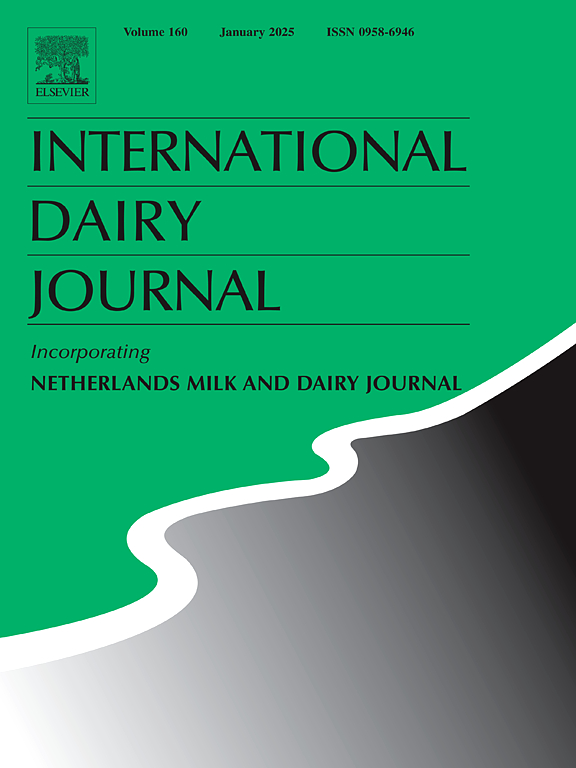First report of enterocin genes in autochthonous Lacticaseibacillus paracasei and Levilactobacillus brevis strains isolated from artisanal dairy products made from raw cow milk
IF 3.4
3区 农林科学
Q2 FOOD SCIENCE & TECHNOLOGY
引用次数: 0
Abstract
Eighteen autochthonous bacteriocin-producing lactic acid bacteria (LAB) isolated from various Algerian artisanal dairy products were identified and characterized using phenotypic and genotypic methods. MALDI-TOF analysis identified 13 isolates (72.22 %) as Lacticaseibacillus paracasei subsp. paracasei and 5 (27.77 %) as Levilactobacillus brevis. The absence of the Enterococcus-specific tuf gene in all isolates further confirmed the identification results. Most of the isolates exhibited strong antibacterial activity against six pathogenic bacteria, with inhibition zone diameters ranging from 10.67 ± 0.58 mm to 27.00 ± 0.00 mm. PCR screening for twelve enterocin-encoding genes detected the presence of entAS-48 and entQ genes in five and four isolates, respectively. Notably, one Levilactobacillus brevis isolate harbored both genes. None of the other enterocin genes were detected in the LAB isolates analyzed. This is the first report of enterocin-encoding genes in non-Enterococcus species, highlighting their potential as novel natural food preservatives and emphasizing Algerian artisanal dairy products as a rich source of bacteriocin-producing LAB.
首次报道从原料牛奶制成的手工乳制品中分离的本地副干酪乳杆菌和短乳酸杆菌菌株的肠毒素基因
采用表型和基因型方法对从阿尔及利亚多种手工乳制品中分离的18株产菌素乳酸菌进行了鉴定和鉴定。MALDI-TOF鉴定出13株(72.22%)为副干酪乳杆菌亚种。5株(27.77%)为短乳杆菌。所有分离株均未发现肠球菌特异性tuf基因,进一步证实了鉴定结果。大部分菌株对6种病原菌均表现出较强的抑菌活性,抑菌带直径范围为10.67±0.58 mm ~ 27.00±0.00 mm。对12个肠球蛋白编码基因进行PCR筛选,分别在5株和4株分离株中检测到entAS-48和entQ基因。值得注意的是,一株短乳杆菌含有这两种基因。在分析的乳酸菌分离株中未检测到其他肠球蛋白基因。这是在非肠球菌物种中首次报道肠素编码基因,强调了它们作为新型天然食品防腐剂的潜力,并强调阿尔及利亚手工乳制品是产生细菌素的乳酸菌的丰富来源。
本文章由计算机程序翻译,如有差异,请以英文原文为准。
求助全文
约1分钟内获得全文
求助全文
来源期刊

International Dairy Journal
工程技术-食品科技
CiteScore
6.50
自引率
9.70%
发文量
200
审稿时长
49 days
期刊介绍:
The International Dairy Journal publishes significant advancements in dairy science and technology in the form of research articles and critical reviews that are of relevance to the broader international dairy community. Within this scope, research on the science and technology of milk and dairy products and the nutritional and health aspects of dairy foods are included; the journal pays particular attention to applied research and its interface with the dairy industry.
The journal''s coverage includes the following, where directly applicable to dairy science and technology:
• Chemistry and physico-chemical properties of milk constituents
• Microbiology, food safety, enzymology, biotechnology
• Processing and engineering
• Emulsion science, food structure, and texture
• Raw material quality and effect on relevant products
• Flavour and off-flavour development
• Technological functionality and applications of dairy ingredients
• Sensory and consumer sciences
• Nutrition and substantiation of human health implications of milk components or dairy products
International Dairy Journal does not publish papers related to milk production, animal health and other aspects of on-farm milk production unless there is a clear relationship to dairy technology, human health or final product quality.
 求助内容:
求助内容: 应助结果提醒方式:
应助结果提醒方式:


